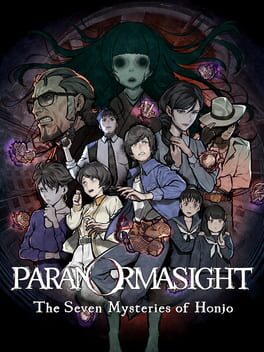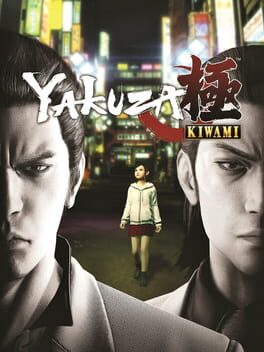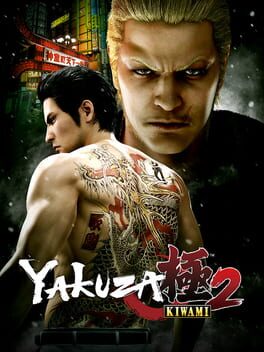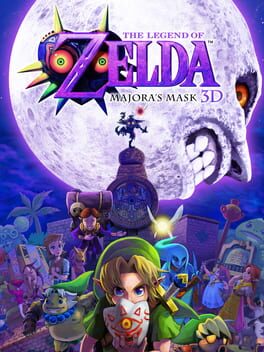Mr_Robotto
2 reviews liked by Mr_Robotto
‘The dead themselves have no regrets; how could they? They are dead and that is all. Only those remaining regret their passing.’
– Natsuhiko Kyogoku, Ubume no natsu, 1994.
Played with BertKnot. The game and this review mention extremely difficult events related to crimes, violence and abuse.
Contemporary Japanese culture is fuelled by a cycle of moral panics generated by high-profile criminal cases. Some, though mysterious, do not escalate into the gruesome, such as the 300 million yen robbery (1968), but others take a far more horrific course. The murders of Tsutomu Miyazaki are an enduring trauma for the Japanese, who associate them with the figure of the otaku, who has sunk into deep madness to the point of committing monstrous acts of violence. Other individuals have followed in his footsteps and continue to fuel the hatred of marginalised groups. Such events are not unique to Japan, but its artistic production always flirts with these traumas without ever completely overcoming them.
The shakai tradition in Japanese crime fiction
However, there is a long literary tradition built around these themes, and the detective genre is no stranger to them. Critics refer to these titles as shakai-ha, a literary trend that is primarily concerned with its social dimension. The mystery plays a fundamental role, not because of its complexity or brilliance – although these are not excluded – but because it reveals the malaise of a society whose social norms are no longer accepted by its members. The historical roots of this genre can be found in the works of Seichō Matsumoto. Suna no Utsuwa (1961), undoubtedly his most famous work, features a detective whose obsession with a criminal case disintegrates his personal life. Depicting a post-war Japan in the midst of hectic reconstruction, the novel describes a family in which the father is absent and the wife is in charge of the household and the children's education. Moreover, the reasons for the crimes underline the plight of Japanese women, caught between the ideal of yamato nadeshiko and rapid modernisation.
The prevalence of suicide in Matsumoto's works raises the question of its chronic nature in Japan. Masāki Kato has analysed a large sample of suicides and notes their anomic nature after World War II, to borrow Durkheim's terminology. [1] It is a feeling of general dissatisfaction with the inability to find one's place in society. For these individuals, it is necessary to adhere to particularly rigid social rules, and the slightest deviation from these idealised norms is grounds for suicide. Taking one's own life and that of others is the fundamental question that runs through the shakai genre. After Matsumoto, a tradition of female writers has emerged, especially since the 1990s. These stories focus on female characters who are confronted with a changing world. They face a socio-economic crisis that exacerbates the systemic sexism they experience. In Miyuki Miyabe's Kasha (1992), crime gives women a new independence after being denied by the social contract of Japanese society. As the losers of urbanisation and modernisation, they can escape from their low-paid jobs, fuelled by desperation and the desire for a better life – or to escape unbearable situations such as debt harassment.
The paranormal to create a chilling horror
If Japanese video games were quick to adopt the detective genre and produce remarkable adventures, starting with Portopia renzoku satsujin jiken (1983), they were inspired above all by the honkaku and shin honkaku genres, which reject shakai realism. On the contrary, the murders have to be particularly complex and have an aura of impossibility, which creates an intellectual game between the author and the reader. Social themes are not completely absent, but they are relegated to the background in favour of the mystery itself. There is certainly a sense of tragedy in the murders, which can be explained by difficult circumstances or sociological trends, but they explain the mystery in retrospect rather than being the crux of the narrative. Famicom Tantei Club: Kieta Kōkeisha (1988) touches on the issue of the zaibatsu and their influence on the economy of certain regions, but it is a very secondary element in the plot.
Paranormasight: The Seven Mysteries of Honjo goes against this tradition, anchoring its story in the shakai style while incorporating elements of shin honkaku. At first glance, it appears to be a horror game inspired by Japanese mythology – the Honjo Nanafushigi are genuine legends and have been adapted in films by Shinko Kimura (Honjo Nanafushigi, 1937) and Katano Goro (Kaidan Honjo Nanafushigi, 1957). However, after the prologue, the tone shifts to become a long investigation depicting the malaise of Japanese society as the years of prosperity come to an end and the first signs of the bursting of the economic bubble in the early 1980s are felt. The player takes on the role of several characters caught up in a curse that has engulfed the Honjo district of Tokyo's Sumida. They are awakened by terrifying ghostly apparitions that urge them to commit murders in order to perform the Rite of Resurrection. This ritual would allow them to bring back to life a person of their choice, at the cost of the soul dregs collected from murdered people. Each protagonist is then able to use a curse to slaughter any person at night, as long as the conditions, inspired by urban legends circulating in Honjo, are met. The first protagonist, Shogo Okiie, meets Yoko Fukunaga in the prologue, who asks for his help in uncovering the truth behind the legend of the Whispering Canal; he is drawn into a series of violent deaths that the player must understand in order to unravel the Seven Mysteries of Honjo and the murders taking place in the neighbourhood.
The game is characterised by its atmosphere, which is supported by a unique art direction. The cold blue colours make Honjo's atmosphere frightening and underline the subtle tension between the various curse-bearers fighting for their survival. Gen Kobayashi's character design alternates between realistic softness and frightening expressions of terror. Dread is conveyed through wide eyes and plays with off-screen action. The player is frightened not so much by the jumpscares, but by the prospect of having to turn around to see them. The backgrounds, slightly distorted as if through a short focus lens, convey a sense of unease through the hollowness of their composition. Paranormasight brilliantly uses oblique shots and atypical staging of characters to emphasise the brooding nature of the discussions, while the architecture of the city overwhelms them.
On social representation through cultural references
Komagata High School is thus a reference to Ushimitsu High School from Famicom Tantei Club Part II: Ushiro ni Tatsu Shōjo (1989), with identical shots, but the coldness of the colour palette in Paranormasight makes the high school very disturbing; it is less a place of education to prepare students for the future, but rather a place where social inequalities and violence are reproduced, something that Japan accepts without flinching. The inadequacy of the teaching staff and the prevalence of juvenile delinquency are signs of the failure of Japanese social policy. The various female characters suffer from this, condemning them to academic failure or worse. Paranormasight takes up the plot of Sukeban deka (1976), a pivotal shōjo manga of the 1980s: it features Saki Asamiya, a delinquent high school girl who ends up helping the police solve several investigations, notably the apparent suicide of one of her best friends, Junko Yuina. The game very explicitly recreates the character of Saki through Yakko Sakazaki, be it in personality, appearance or motives.
In general, the game takes familiar elements of Japanese culture to modernise and comment on them. This is particularly the case with the female characters, who regain a high degree of agency in the pure shakai tradition. At first glance, Harue Shigima seems to be the embodiment of the yamato nadeshiko, full of the ideals associated with a traditional Japan, but the death of her son and the curse give her the energy to fight against the weight of society. Despite her tired appearance, she displays a very subtle wit through her careful and respectful speech. Yakko is particularly proactive and confident, following the example of Sukeban deka, while her friend Mio, a specialist in occult matters, is presented as a voice of reason, contrary to the cliché of the mad witch. This complex nature of the female characters is echoed in a more fragile representation of masculinity. The various male characters are presented with characteristics that undermine the myth of traditional, honour-bound masculinity. They are generally cowardly or display marginal masculinity. If Tetsuo Tsutsumi represents the serious and unyielding inspector, he is often the comedic force of the group, with deadpan remarks that take the edge off the game's terrifying tension. Richter Kai portrays a more jovial and chaotic manliness through his love of childish things, which leads to Harue's amused comments.
Paranormasight quickly reveals itself to be a title with a sharp critique of all forms of authority. The police are portrayed as an institution incapable of preventing crime and serving the public. While officers like Hajime Yoshimi try to be more akin to a social worker for troubled teenage girls, he is generally unable to structurally solve their problems, offering only what he can, namely a shoulder to lean on. The characters lament the fact that Japanese law prohibits police officers from intervening in cases of domestic violence – a situation that only changed with the Act on the Prevention of Spousal Violence and the Protection of Victims (2001). Hierarchical frameworks dictate behaviour in Japanese suburbs. Paranormasight repeatedly emphasises the importance of the dichotomy between the public face (tatamae) and the private face (honne). Michiyo Shiraishi's neighbours are sympathetic until the Shiraishi family strays from the discretion expected in a neighbourhood. Even within the working class, solidarity is not taken for granted and depends on adherence to social rules, however rigid and conservative they may be. The title also insists on the hypocrisy of the family myth, with reference to the coin-operated locker babies, who, for various socio-economic reasons, were abandoned newborn babies in lockers and left to die. This phenomenon, which was widespread between the 1970s and 1990s, haunts the various characters in the game.
Instantiating horror in a real setting: how to modernise a social representation?
It is precisely because these elements are central to Paranormasight's horror and mystery that the game works. The soundtrack is particularly effective in creating a strong atmosphere, alternating between dissonant tracks and music inspired by the emerging city pop of the time. The game is concerned with social modernity in its discourse: it is about representing 1980s Tokyo with respect to the social progress of 2023. The title is therefore against prison and in favour of rehabilitation, rejecting the idea that crimes are inherited through blood. Paranormasight, even though its plot is based on elements of Japanese mythology, stands out for its ability to tell a story whose social motives would remain the same even without the occult. In an eternal Buddhist cycle, the ills of society remain the same until structural measures are implemented by decision-makers, as illustrated by the chronic pollution of the Sumida River, the visual centre of the title.
In terms of gameplay, Paranormasight clearly borrows from recent adventure games, notably the Switch port of Famicom Detective Club (2021) and the second Ace Attorney trilogy. The grammar remains that of 1980s games, with the necessity to repeatedly bring up the same topic of conversation, but the game clearly indicates when all actions have been completed, or if further exploration and dialogue is required. The title uses the Story Chart system inherited from Kono Yo no Hate de Koi o Utau Shōjo YU-NO (1996) and Kotaro Uchikoshi's games, and tries to be as clear as possible about the branching paths the player needs to explore in order to follow the different narrative threads. It is only towards the end of the game that Paranormasight becomes more cryptic, although this does not cause any major problems. The title really tests the player's understanding of the case with relatively open-ended questions. These sequences are particularly effective because the player is always in a strong position compared to the protagonists. Having a transversal knowledge of the events, they are able to theorise in advance and identify the blind spots in the characters' deductions. This narrative style helps to create the impression that the protagonists are conducting a real investigation, with all the complexity this implies.
Paranormasight manages to modernise the adventure and detective genres with a believable story, despite the presence of supernatural elements. Carried by a deep and touching cast, the title presents an ingenious mystery rooted in the malaise of a society on the verge of collapse. Poverty, pollution, a crisis in education and a sense of alienation exacerbate a generational clash. The protagonists, although caught up in a curse that transcends them, are only individuals among others in Tokyo who harbour regrets, remorse and sadness. As the sun sets, the Sumida River turns bloody. The real killer is a city that is oversized and relentless. Paranormasight illustrates this unease with a unique horror texture, instantiating it in the physical reality of Honjo. If Japanese crime fiction has always insisted on the importance of locales while promoting mindful tourism – indeed, since 2001, this has been the function of the Mystery Tours in Meitantei Konan (1994) –, the game accomplishes an astonishing tour de force and establishes itself as a modern shakai staple for the video game medium.
__________
[1] Masāki Kato, ‘Self-Destruction in Japan: A Crosscultural, Epidemiological Analysis of Suicide’, in Folia Psychiatrica et Neurologica, vol. 23, no. 4, 1969, pp. 291-307.
– Natsuhiko Kyogoku, Ubume no natsu, 1994.
Played with BertKnot. The game and this review mention extremely difficult events related to crimes, violence and abuse.
Contemporary Japanese culture is fuelled by a cycle of moral panics generated by high-profile criminal cases. Some, though mysterious, do not escalate into the gruesome, such as the 300 million yen robbery (1968), but others take a far more horrific course. The murders of Tsutomu Miyazaki are an enduring trauma for the Japanese, who associate them with the figure of the otaku, who has sunk into deep madness to the point of committing monstrous acts of violence. Other individuals have followed in his footsteps and continue to fuel the hatred of marginalised groups. Such events are not unique to Japan, but its artistic production always flirts with these traumas without ever completely overcoming them.
The shakai tradition in Japanese crime fiction
However, there is a long literary tradition built around these themes, and the detective genre is no stranger to them. Critics refer to these titles as shakai-ha, a literary trend that is primarily concerned with its social dimension. The mystery plays a fundamental role, not because of its complexity or brilliance – although these are not excluded – but because it reveals the malaise of a society whose social norms are no longer accepted by its members. The historical roots of this genre can be found in the works of Seichō Matsumoto. Suna no Utsuwa (1961), undoubtedly his most famous work, features a detective whose obsession with a criminal case disintegrates his personal life. Depicting a post-war Japan in the midst of hectic reconstruction, the novel describes a family in which the father is absent and the wife is in charge of the household and the children's education. Moreover, the reasons for the crimes underline the plight of Japanese women, caught between the ideal of yamato nadeshiko and rapid modernisation.
The prevalence of suicide in Matsumoto's works raises the question of its chronic nature in Japan. Masāki Kato has analysed a large sample of suicides and notes their anomic nature after World War II, to borrow Durkheim's terminology. [1] It is a feeling of general dissatisfaction with the inability to find one's place in society. For these individuals, it is necessary to adhere to particularly rigid social rules, and the slightest deviation from these idealised norms is grounds for suicide. Taking one's own life and that of others is the fundamental question that runs through the shakai genre. After Matsumoto, a tradition of female writers has emerged, especially since the 1990s. These stories focus on female characters who are confronted with a changing world. They face a socio-economic crisis that exacerbates the systemic sexism they experience. In Miyuki Miyabe's Kasha (1992), crime gives women a new independence after being denied by the social contract of Japanese society. As the losers of urbanisation and modernisation, they can escape from their low-paid jobs, fuelled by desperation and the desire for a better life – or to escape unbearable situations such as debt harassment.
The paranormal to create a chilling horror
If Japanese video games were quick to adopt the detective genre and produce remarkable adventures, starting with Portopia renzoku satsujin jiken (1983), they were inspired above all by the honkaku and shin honkaku genres, which reject shakai realism. On the contrary, the murders have to be particularly complex and have an aura of impossibility, which creates an intellectual game between the author and the reader. Social themes are not completely absent, but they are relegated to the background in favour of the mystery itself. There is certainly a sense of tragedy in the murders, which can be explained by difficult circumstances or sociological trends, but they explain the mystery in retrospect rather than being the crux of the narrative. Famicom Tantei Club: Kieta Kōkeisha (1988) touches on the issue of the zaibatsu and their influence on the economy of certain regions, but it is a very secondary element in the plot.
Paranormasight: The Seven Mysteries of Honjo goes against this tradition, anchoring its story in the shakai style while incorporating elements of shin honkaku. At first glance, it appears to be a horror game inspired by Japanese mythology – the Honjo Nanafushigi are genuine legends and have been adapted in films by Shinko Kimura (Honjo Nanafushigi, 1937) and Katano Goro (Kaidan Honjo Nanafushigi, 1957). However, after the prologue, the tone shifts to become a long investigation depicting the malaise of Japanese society as the years of prosperity come to an end and the first signs of the bursting of the economic bubble in the early 1980s are felt. The player takes on the role of several characters caught up in a curse that has engulfed the Honjo district of Tokyo's Sumida. They are awakened by terrifying ghostly apparitions that urge them to commit murders in order to perform the Rite of Resurrection. This ritual would allow them to bring back to life a person of their choice, at the cost of the soul dregs collected from murdered people. Each protagonist is then able to use a curse to slaughter any person at night, as long as the conditions, inspired by urban legends circulating in Honjo, are met. The first protagonist, Shogo Okiie, meets Yoko Fukunaga in the prologue, who asks for his help in uncovering the truth behind the legend of the Whispering Canal; he is drawn into a series of violent deaths that the player must understand in order to unravel the Seven Mysteries of Honjo and the murders taking place in the neighbourhood.
The game is characterised by its atmosphere, which is supported by a unique art direction. The cold blue colours make Honjo's atmosphere frightening and underline the subtle tension between the various curse-bearers fighting for their survival. Gen Kobayashi's character design alternates between realistic softness and frightening expressions of terror. Dread is conveyed through wide eyes and plays with off-screen action. The player is frightened not so much by the jumpscares, but by the prospect of having to turn around to see them. The backgrounds, slightly distorted as if through a short focus lens, convey a sense of unease through the hollowness of their composition. Paranormasight brilliantly uses oblique shots and atypical staging of characters to emphasise the brooding nature of the discussions, while the architecture of the city overwhelms them.
On social representation through cultural references
Komagata High School is thus a reference to Ushimitsu High School from Famicom Tantei Club Part II: Ushiro ni Tatsu Shōjo (1989), with identical shots, but the coldness of the colour palette in Paranormasight makes the high school very disturbing; it is less a place of education to prepare students for the future, but rather a place where social inequalities and violence are reproduced, something that Japan accepts without flinching. The inadequacy of the teaching staff and the prevalence of juvenile delinquency are signs of the failure of Japanese social policy. The various female characters suffer from this, condemning them to academic failure or worse. Paranormasight takes up the plot of Sukeban deka (1976), a pivotal shōjo manga of the 1980s: it features Saki Asamiya, a delinquent high school girl who ends up helping the police solve several investigations, notably the apparent suicide of one of her best friends, Junko Yuina. The game very explicitly recreates the character of Saki through Yakko Sakazaki, be it in personality, appearance or motives.
In general, the game takes familiar elements of Japanese culture to modernise and comment on them. This is particularly the case with the female characters, who regain a high degree of agency in the pure shakai tradition. At first glance, Harue Shigima seems to be the embodiment of the yamato nadeshiko, full of the ideals associated with a traditional Japan, but the death of her son and the curse give her the energy to fight against the weight of society. Despite her tired appearance, she displays a very subtle wit through her careful and respectful speech. Yakko is particularly proactive and confident, following the example of Sukeban deka, while her friend Mio, a specialist in occult matters, is presented as a voice of reason, contrary to the cliché of the mad witch. This complex nature of the female characters is echoed in a more fragile representation of masculinity. The various male characters are presented with characteristics that undermine the myth of traditional, honour-bound masculinity. They are generally cowardly or display marginal masculinity. If Tetsuo Tsutsumi represents the serious and unyielding inspector, he is often the comedic force of the group, with deadpan remarks that take the edge off the game's terrifying tension. Richter Kai portrays a more jovial and chaotic manliness through his love of childish things, which leads to Harue's amused comments.
Paranormasight quickly reveals itself to be a title with a sharp critique of all forms of authority. The police are portrayed as an institution incapable of preventing crime and serving the public. While officers like Hajime Yoshimi try to be more akin to a social worker for troubled teenage girls, he is generally unable to structurally solve their problems, offering only what he can, namely a shoulder to lean on. The characters lament the fact that Japanese law prohibits police officers from intervening in cases of domestic violence – a situation that only changed with the Act on the Prevention of Spousal Violence and the Protection of Victims (2001). Hierarchical frameworks dictate behaviour in Japanese suburbs. Paranormasight repeatedly emphasises the importance of the dichotomy between the public face (tatamae) and the private face (honne). Michiyo Shiraishi's neighbours are sympathetic until the Shiraishi family strays from the discretion expected in a neighbourhood. Even within the working class, solidarity is not taken for granted and depends on adherence to social rules, however rigid and conservative they may be. The title also insists on the hypocrisy of the family myth, with reference to the coin-operated locker babies, who, for various socio-economic reasons, were abandoned newborn babies in lockers and left to die. This phenomenon, which was widespread between the 1970s and 1990s, haunts the various characters in the game.
Instantiating horror in a real setting: how to modernise a social representation?
It is precisely because these elements are central to Paranormasight's horror and mystery that the game works. The soundtrack is particularly effective in creating a strong atmosphere, alternating between dissonant tracks and music inspired by the emerging city pop of the time. The game is concerned with social modernity in its discourse: it is about representing 1980s Tokyo with respect to the social progress of 2023. The title is therefore against prison and in favour of rehabilitation, rejecting the idea that crimes are inherited through blood. Paranormasight, even though its plot is based on elements of Japanese mythology, stands out for its ability to tell a story whose social motives would remain the same even without the occult. In an eternal Buddhist cycle, the ills of society remain the same until structural measures are implemented by decision-makers, as illustrated by the chronic pollution of the Sumida River, the visual centre of the title.
In terms of gameplay, Paranormasight clearly borrows from recent adventure games, notably the Switch port of Famicom Detective Club (2021) and the second Ace Attorney trilogy. The grammar remains that of 1980s games, with the necessity to repeatedly bring up the same topic of conversation, but the game clearly indicates when all actions have been completed, or if further exploration and dialogue is required. The title uses the Story Chart system inherited from Kono Yo no Hate de Koi o Utau Shōjo YU-NO (1996) and Kotaro Uchikoshi's games, and tries to be as clear as possible about the branching paths the player needs to explore in order to follow the different narrative threads. It is only towards the end of the game that Paranormasight becomes more cryptic, although this does not cause any major problems. The title really tests the player's understanding of the case with relatively open-ended questions. These sequences are particularly effective because the player is always in a strong position compared to the protagonists. Having a transversal knowledge of the events, they are able to theorise in advance and identify the blind spots in the characters' deductions. This narrative style helps to create the impression that the protagonists are conducting a real investigation, with all the complexity this implies.
Paranormasight manages to modernise the adventure and detective genres with a believable story, despite the presence of supernatural elements. Carried by a deep and touching cast, the title presents an ingenious mystery rooted in the malaise of a society on the verge of collapse. Poverty, pollution, a crisis in education and a sense of alienation exacerbate a generational clash. The protagonists, although caught up in a curse that transcends them, are only individuals among others in Tokyo who harbour regrets, remorse and sadness. As the sun sets, the Sumida River turns bloody. The real killer is a city that is oversized and relentless. Paranormasight illustrates this unease with a unique horror texture, instantiating it in the physical reality of Honjo. If Japanese crime fiction has always insisted on the importance of locales while promoting mindful tourism – indeed, since 2001, this has been the function of the Mystery Tours in Meitantei Konan (1994) –, the game accomplishes an astonishing tour de force and establishes itself as a modern shakai staple for the video game medium.
__________
[1] Masāki Kato, ‘Self-Destruction in Japan: A Crosscultural, Epidemiological Analysis of Suicide’, in Folia Psychiatrica et Neurologica, vol. 23, no. 4, 1969, pp. 291-307.
Hypnospace Outlaw
2019
A memorial and portrait of a time "lost", with the paint bleeding through the page to imprint on the user, hoping for them to understand what we might bring to today. Each brushstroke an elegant capture of people and the communication between them, shared through the tendrils of corporation forever omnipresent then as it is now. And they all share the same message. There's no going back. Reflect now and move forward, because we as a people still are the same expressions of love and joy, regardless of how much it appears to have superficially changed.






